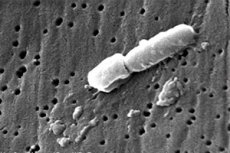A cikk orvosi szakértője
Új kiadványok
Klebsiella egy felnőtt és egy gyermek székletében
Utolsó ellenőrzés: 07.07.2025

Minden iLive-tartalmat orvosi szempontból felülvizsgáltak vagy tényszerűen ellenőriznek, hogy a lehető legtöbb tényszerű pontosságot biztosítsák.
Szigorú beszerzési iránymutatásunk van, és csak a jó hírű média oldalakhoz, az akadémiai kutatóintézetekhez és, ha lehetséges, orvosilag felülvizsgált tanulmányokhoz kapcsolódik. Ne feledje, hogy a zárójelben ([1], [2] stb.) Szereplő számok ezekre a tanulmányokra kattintható linkek.
Ha úgy érzi, hogy a tartalom bármely pontatlan, elavult vagy más módon megkérdőjelezhető, jelölje ki, és nyomja meg a Ctrl + Enter billentyűt.

A Klebsiella egy enterobaktérium-típus, amely feltételesen patogén mikroorganizmus. Ezek kapszula alakú Gram-negatív pálcák, amelyek egyesével, párokban vagy láncokban helyezkednek el. Nagyon veszélyesnek tekintik őket, mivel rezisztensek a meglévő antibiotikumokkal szemben. Megtalálhatók a bőrön, a légzőrendszerben, a vízben, a talajban, a zöldségekben és gyümölcsökben, a székletben. A héj segít nekik túlélni bármilyen táptalajban, levegő nélkül is létezhetnek, és csak a forralás pusztítja el őket.
Klebsiella norma a székletvizsgálatban
A Klebsiellát a diszbakteriózis székletvizsgálata során észlelik. Jelenléte nem a patológia jele, ha nem haladja meg a normát - 10 5 sejt grammonként.
Ahhoz, hogy a baktériumok aktívvá váljanak, olyan tényezőkre van szükség, amelyek ezt elősegítik: legyengült immunitás, antibiotikumok hosszú távú szedése, a higiéniai szabályok be nem tartása (mosatlan kéz, ételek), cukorbetegség, alkoholizmus és drogfüggőség. [ 1 ]
Klebsiella tüdőgyulladás a székletben
A Klebsiella 7 változata létezik, ezek egyike a Klebsiella pneumoniae. Eredetileg tüdőgyulladás kórokozójaként fedezték fel, innen ered a neve is. Később kiderült, hogy szaporodása méreganyagok felszabadulásához vezet, amelyek károsodása más betegségeket is okozhat, beleértve az urogenitális húgyhólyaggyulladást, a lép- és májtályogokat, a mellhártyagyulladást és számos más betegséget. A baktérium a székletben is megtalálható. [ 2 ]
Klebsiella oxytoca a székletben
A székletben található másik baktériumtípus a Klebsiella oxytoca. Emésztési zavarokat, tüdőgyulladást okoz. [ 3 ]
Klebsiella a székletben felnőtteknél
A Klebsiella feco-orális és kontakt-háztartási úton terjed. A tiszta kéz szabályát és a termékek megfelelő hőkezelését figyelmen kívül hagyó felnőtt legyengült szervezetét opportunista baktériumok támadják meg, akut tüneteket okozva. A székletvizsgálat a bacilusok geometriai progresszióban történő növekedését mutatja.
Ha egy családtag megbetegszik, nagy a valószínűsége annak, hogy mások is megfertőződnek.
Klebsiella a gyermek székletében
A gyermekek különösen fogékonyak a betegségre, mivel gyakran érintkeznek állatokkal, és nem értik a higiénia fontosságát. A Klebsiella egy ideig békésen együtt élhet bennük, de csak akkor, amikor eljön a megfelelő pillanat az aktiválódásukra, a betegség megnyilvánul.
A csecsemők Klebsiella fertőzésének esetei gyakoriak. Az újszülöttek immunitása gyenge, nem teljesen kialakult, a belső szervek nyálkahártyája steril, ezért nagyon érzékenyek a bacillus toxinok káros hatásaira. Az oxitokok általában megtalálhatók a székletükben.
Felnőttektől levegőben lévő cseppek útján fertőződhet meg, míg maguk a hordozók nem szenvednek, védekezőrendszerük megbirkózik a baktériumokkal. A patológia elkapásának további módjai a piszkos cumik, mellbimbók, játékok, valamint etetéskor - erjesztett tejtermékek, hús tartalmazhatja.
Tünetek
A Klebsiella fertőzés tünetei a lézió helyétől függenek. Ha a gyomor-bél traktus érintett, akkor az akut mérgezés tünetei jelentkeznek:
- hasi fájdalom;
- hányinger és hányás,
- magas testhőmérséklet;
- hasmenés;
- testfájdalmak;
- étvágytalanság.
A Klebsiella okozta tüdőgyulladás hirtelen, 39°C fölé emelkedő testhőmérsékletet, erős köhögést, néha véres váladékot okoz a köpetben. Emellett előfordulhat orrnyálkahártya-gyulladás, arcüreggyulladás és kötőhártya-gyulladás is, amelyekre jellemző tünetek vonatkoznak: orrfolyás, könnyezés, szemfájdalom és -csípő érzés, orrdugulás.
Az urogenitális rendszer gyakran érintett: cystitis és pyelonephritis diagnosztizálható, melyeket gyakori WC-késés, fájdalmas vizelés, zavaros vizelet, alhasi fájdalom, gyakran hátra sugárzó testhőmérséklet kísér.
Nőknél és lányoknál a Klebsiella hüvelygyulladást okozhat, amelyet a fehér vagy szürke színű, bőséges hüvelyi folyás jellemez, kellemetlen szaggal és viszketéssel.
A csontrendszer bevonása a kóros folyamatba, beleértve az ízületi gyulladás provokációját is, nem kivétel.
Kezelés
Klebsiella fertőzés esetén a kórokozóra érzékeny antibiotikumokat írnak fel. Ezek lehetnek gentamicin, amikacin, cefalosporinok: cefotaxim, cefuroxim. A bacilust vírusos ágensek - bakteriofágok: Klebsiella pneumoniae, oxycyta, polyvalent - segítségével is elpusztítják.
Ezzel párhuzamosan enzimeket használnak: pankreatint, linexet, festalt; rehidratáló oldatokat. Súlyos esetekben immunstimulánsok megfelelőek. A kezelés időtartama egy héttől háromig tarthat. A rehabilitációhoz probiotikumokat, vitaminkészítményeket és gyógynövényes infúziókat használnak.
A megfelelő és időszerű kezelés kedvező prognózist ad a gyógyulásra, de a bacillusok elszaporodásának progressziója veszélyes következményeket okoz, beleértve a halált is.

